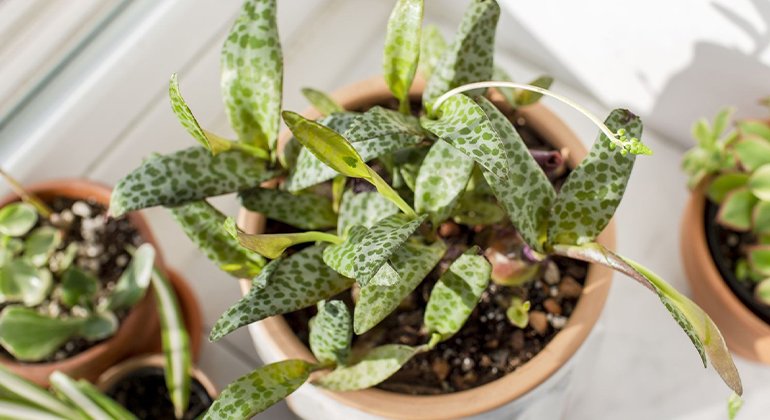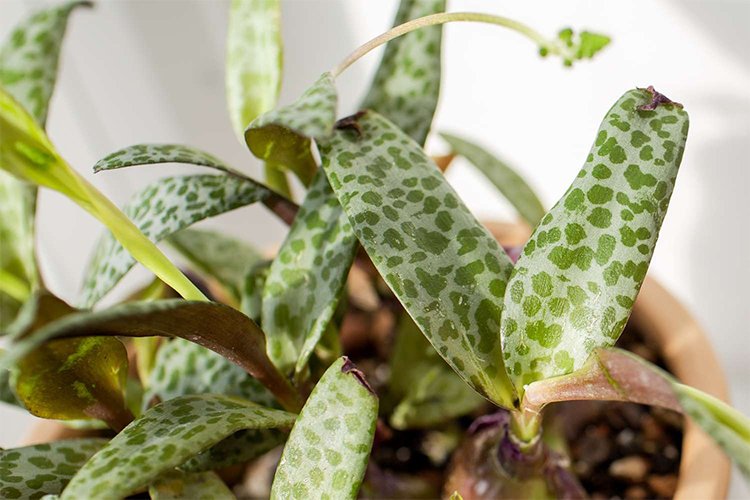
A small but sturdy and resilient species, the Squill is native to the dry savannas of South Africa. This perennial is known as a colorful and striking houseplant, but can also be grown as a ground cover and in xeriscape gardens in warmer climates. It is best planted in spring to take full advantage of its summer growing season.
The Squill has silvery, lance-shaped leaves with green leopard spots and silver spots and purple on the underside. Mature plants produce teardrop-shaped bulbs above the ground. The Squill has the ability to store moisture in its stems during times of drought. In spring, small green flowers grow on pink stems that emerge from the rosette-shaped foliage.
Squills are considered particularly easy to care for. They require a winter dormancy period with reduced watering. Reducing water allows the plant to enter its natural dormancy period.
Because the entire plant only grows to about 6 to 10 inches tall, squills are easy to grow both indoors and outdoors in areas with limited space.

The squill needs at least three to four hours of bright, indirect sunlight per day. It often grows in closed evergreen forests that are partially shaded.
Once established, the squill requires minimal water and is considered drought-tolerant, similar to succulents. Make sure the top 1 inch of soil or planting media dry out before watering during the warmer months. During the winter months, the plant is in its dormant phase, so you should water only half as often.
The squill grows best in humus-rich, sandy soil, but it will also grow in rocky soil with a pH between 6 and 8. Well-drained soil is essential.
If you are growing squills indoors as houseplants, indoor temperatures are generally acceptable. Outdoors, the plant thrives best when the ambient temperature is 15°C or more. Squills can tolerate winter temperatures as low as -1°C. The plant thrives best in low to average humidity.
During the spring and summer growing season, use a balanced liquid fertilizer every two months for plants in the ground and monthly for potted plants.
There is no clear horticultural nomenclature for squill cultivars, but these are commonly used names for various varieties1:
Ledebouria socialis ‘Juda’, with variegated light yellow or bright pink striped leaves
Ledebouria socialis ‘Miner’ (‘Minor’), a dwarf variety
Ledebouria socialis ‘Paucifolia’, its leaves are shorter than the leaves of other varieties, silvery-white with dark green dots
Ledebouria socialis ‘Violacea’, with silvery leaves with dark green spots on the upper side and purple on the lower side, which gave this variety its name
Pruning
Other than removing yellow or dead leaves and plant debris, squill does not require much pruning.

Although it is possible to propagate squill by seed, germination can be erratic and growth can also be very slow. Therefore, the plants are usually propagated by dividing the bulb clusters. Here’s how to do it:
After the flowers have faded, remove the plant from its pot or lift it out of the ground.
Gently break the bulbs into individual sections and replant each section in pots or garden soil, leaving one-third to one-half of the bulb above the soil surface. If planting the bulbs in containers, plant no more than three bulbs in a 4- to 6-inch pot.
Water immediately and keep the soil evenly moist until you see new growth.
The silver squill needs well-draining potting soil or succulent and cactus mix and a container with plenty of drainage holes. Terra cotta is best because it allows excess moisture to evaporate.
The bulbs will multiply over time until the plant becomes too crowded in its pot. When this happens, it is time to repot the plant into a larger pot or separate some of the bulbs to grow new plants, following the procedure for propagation by division.
In climates where winter temperatures fall below -1 degrees Celsius, the plant must be overwintered indoors. Place it in a location with bright but indirect light. Water it only occasionally so that the soil does not dry out completely.
Although the silver starfish is usuallyWhile this is not devastating to the plant, it can be attacked by a number of pests, mealybugs, aphids, spider mites, scale insects and thrips. Possible diseases include root rot, leaf spot, grey mould, rust and mildew.
A common reason why the silver starfish does not bloom is that it has not gone through its relatively dry and slightly cooler dormant period. Adjust your watering schedule in winter and move houseplants to a location that is a few degrees coolerthan in spring and summer.
Curled leaves that are turning brown around the edges can be a sign that the plant is getting too much direct sunlight and not enough water. Although the plant needs partial sun, it should not be exposed to harsh, direct sunlight.